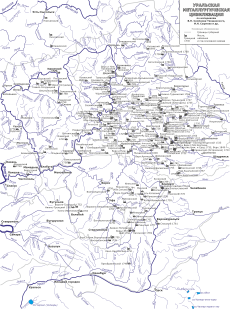Category:Ural Mining Industry civilization
Jump to navigation
Jump to search
Civilisation of the Urals | |||||
| Upload media | |||||
| Instance of | |||||
|---|---|---|---|---|---|
| Subclass of | |||||
| Location |
| ||||
| Discoverer or inventor |
| ||||
| Start time |
| ||||
| End time |
| ||||
| |||||
English: In the 18—19th centuries, successful surveys of various natural resources gave birth to a new Ural civilization, now used to be called "mining civilization" ("Gornozavodskaya"). Ethnographer and literature theorist Prof. Pavel Bogoslovsky proved its existence. From the early 18th to the middle of 19th century, 260 industrial cities have been built in the Urals, i.e. more than half of the cities built in the rest of Russia within the same period. These cities had a distinct purpose and specific style of artistic design. In the first quarter of the 19th century, industrial cities grew big enough to have ensemble architecture, a governorate (regional) architect, and architects of mining factories and areas. A significant part of the Ural culture, these cities are essential from the viewpoint of global science, technology and art. In the 18th century, industrial cities made the Urals not only the area of largest industrial construction, but also the world's largest metallurgy center.
Media in category "Ural Mining Industry civilization"
The following 3 files are in this category, out of 3 total.
-
Ural Metallurgical Civilisation Map.svg 898 × 1,206; 1.73 MB
-
Ural Mining plant Civilisation General Map.svg 673 × 813; 707 KB



